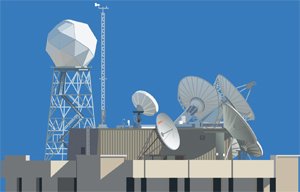Library News
by Jean Phillips
First Public Demo of McIDAS

Four years after its debut in 1973, a revolutionary visualization software package known as the Man computer Interactive Data Access System (McIDAS) had its first public demonstration at the 57th Annual Meeting of the American Meteorological Society held in Tucson, Arizona in January 1977. Developed at the University of Wisconsin-Madison’s Space Science and Engineering Center (SSEC), McIDAS offered a new way of displaying, analyzing, interpreting, acquiring and managing geophysical data. The video “Processing and Display of Satellite and Conventional Meteorological Data for the Classroom,” presented by SSEC’s Tom Whittaker, introduced some of these capabilities to new and potential users. Now nearly forty years after this initial public display, McIDAS continues to be a leading visualization software package, evolving with the changes in satellite sensor technologies and the needs of its users.
To read the article that corresponds to the video on the Schwerdtfeger Library’s YouTube channel, see:
Whittaker, Thomas M. Processing and display of satellite and conventional meteorological data for the classroom. In: Interactive Video Displays for Atmospheric Studies, Proceedings of a Workshop at the University of Wisconsin-Madison, 14-16 June 1977, pp11-24.
When is a specialized database better than Google?
Google searches work well if you only need to find an article or two, but when a literature review or something more complex is necessary – as is often the case in most areas of research – then Google might not be enough.
Why? Google is really a tool for key word searching and if you don’t hit upon the right key word or combination of key words, then you might think, erroneously, that nothing exists on your topic, or at least there is nothing online. Or you might find yourself frustrated because there are too many results altogether.
Enter the specialized research database. A controlled vocabulary, like that found in Web of Science, is central to the organization and structure of disciplinary databases and aids discovery. This means that if you search on “rain” you’ll easily be guided to other articles or work ‘linked’ by a structured vocabulary, all dealing with precipitation in its various forms and relationships.
Further, even when your Google search yields what you think are good results, it’s more difficult to refine them. In a specialized database like Web of Science you can perform a range of operations to narrow or broaden your search. You can refine by selecting other topics or research areas, authors, sources, document types, date ranges or funding agencies. You can use, and reuse, previous search results.
In Web of Science, you also have the ability to:
- Analyze citations forward and backward in time; first and second generation
- Create citation maps for a graphic of citation history of a given paper (see image)
- Find high-impact articles and journals
- Analyze your publishing history in different ways
- Expand your search and discover relevant articles in related or multidisciplinary fields by looking at articles that share the same references
- Discover emerging trends to support your research and proposal writing
- Identify potential collaborators with significant citation records
- Export results to a reference manager so that searching is integrated with writing, and bibliography creation

Cited 143 times, an interactive mapping of articles citing Velden, C.S., 1997:
Upper tropospheric winds derived from geostationary satellite water vapor observations.
BAMS 78, no.2, pp173-195.
Many subject specific databases are including access to even more information by indexing charts and images included in articles, details of experiments, information about datasets and allowing consolidation of information from various services.
Check ‘Research Databases’ on the Library’s homepage for a direct link to Web of Science and other databases relevant to the atmospheric sciences. Not what you need? There are many others depending on your topic. We can help you determine which one is best for you.

